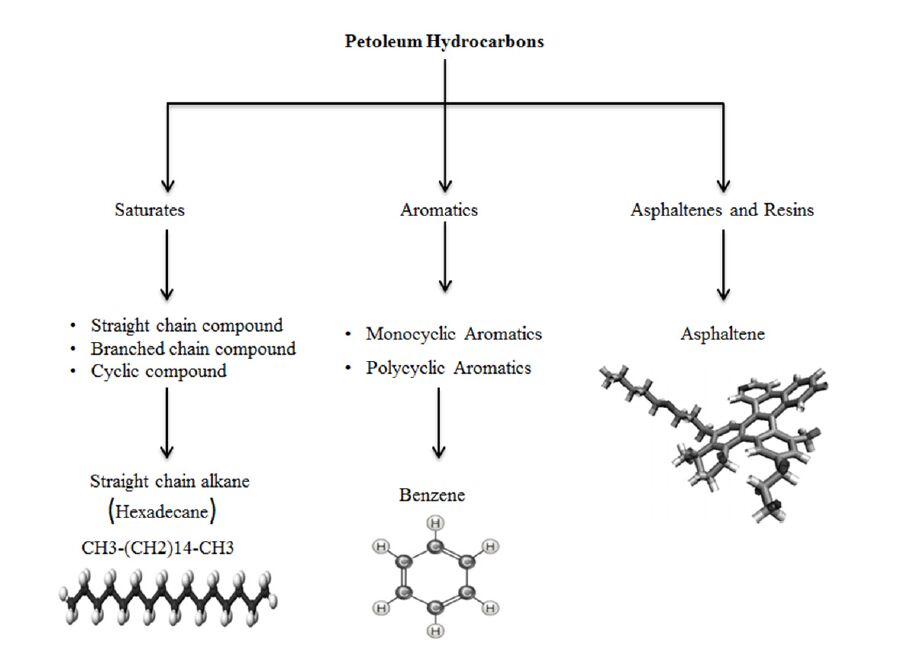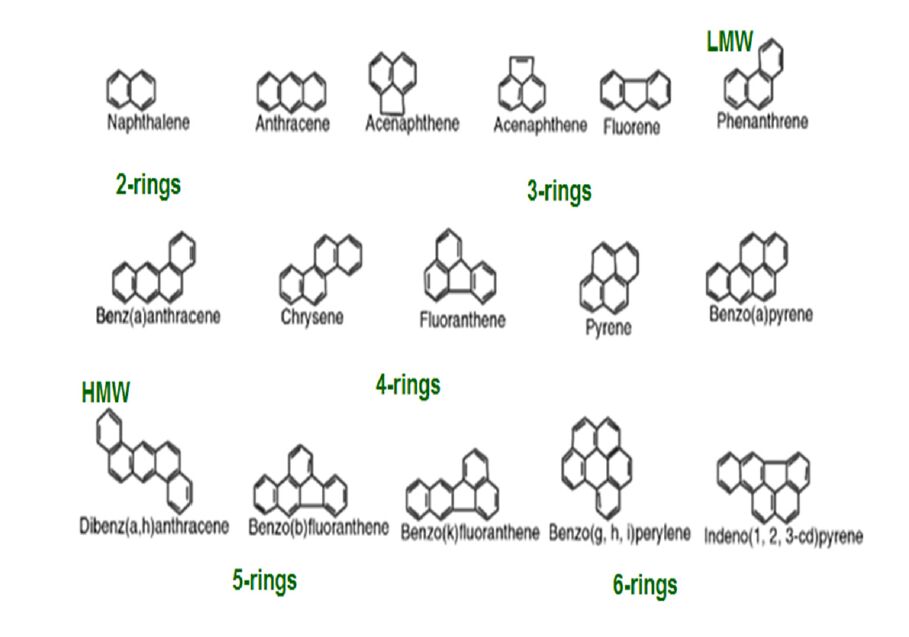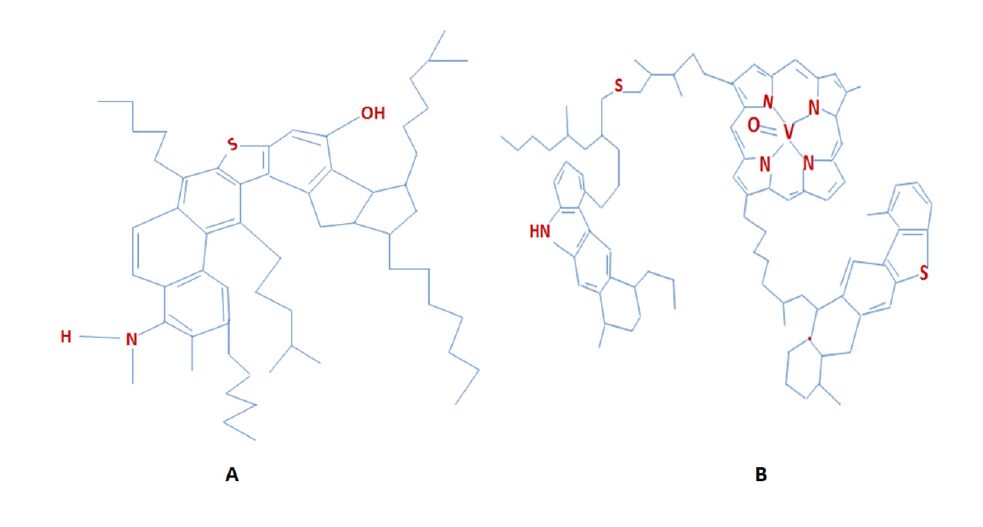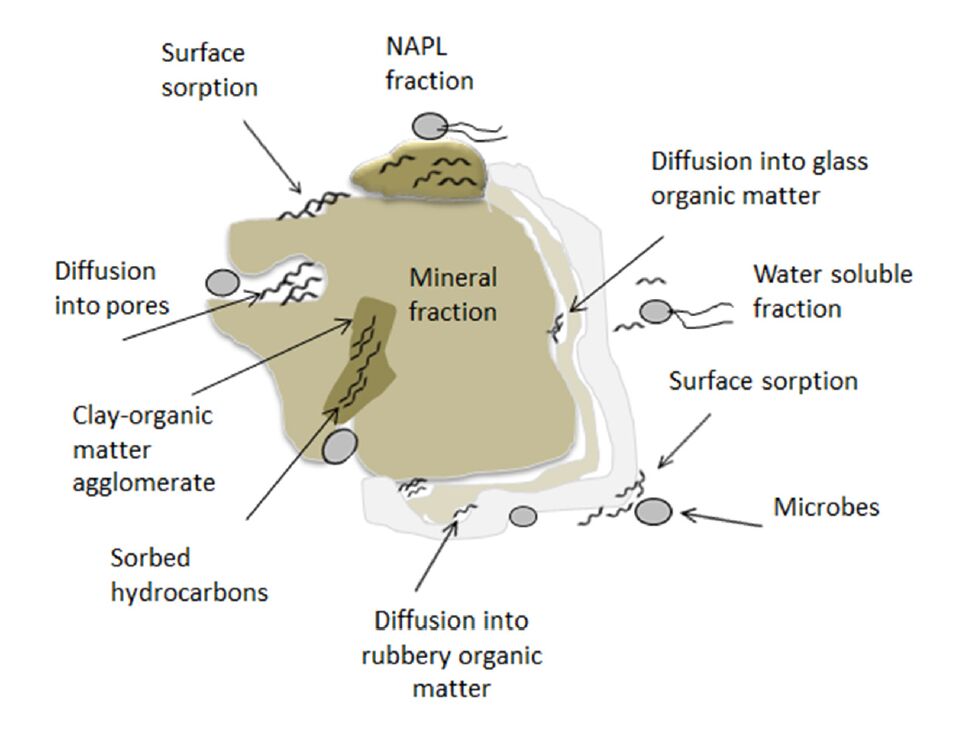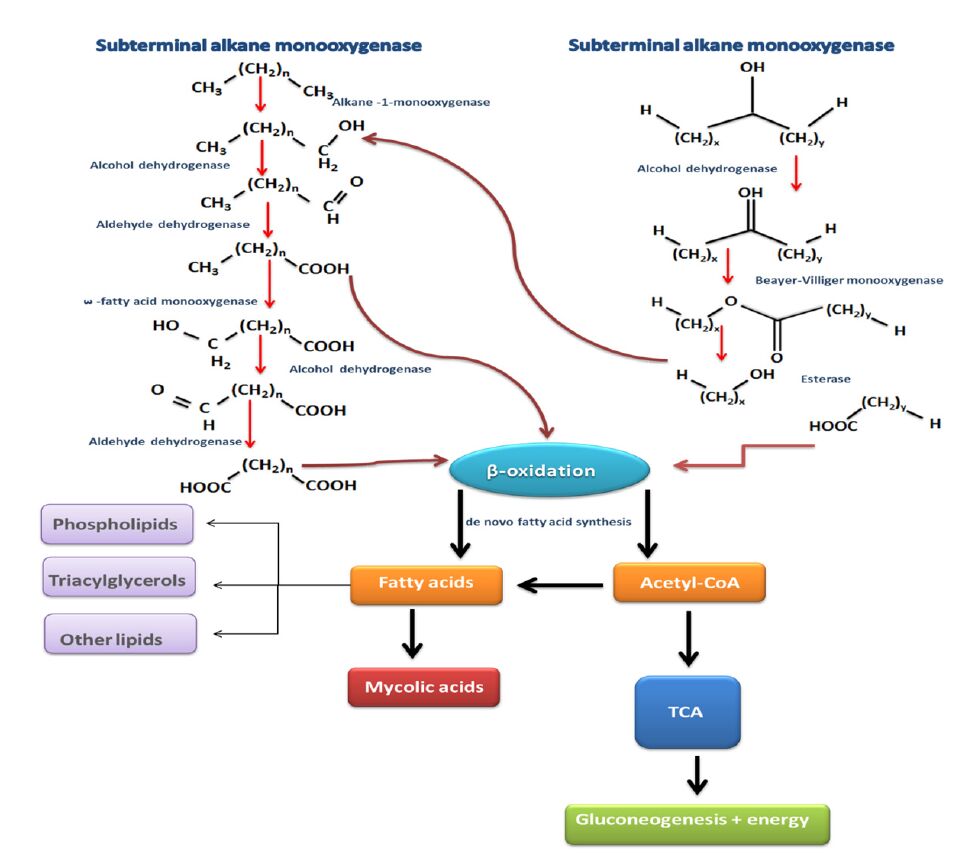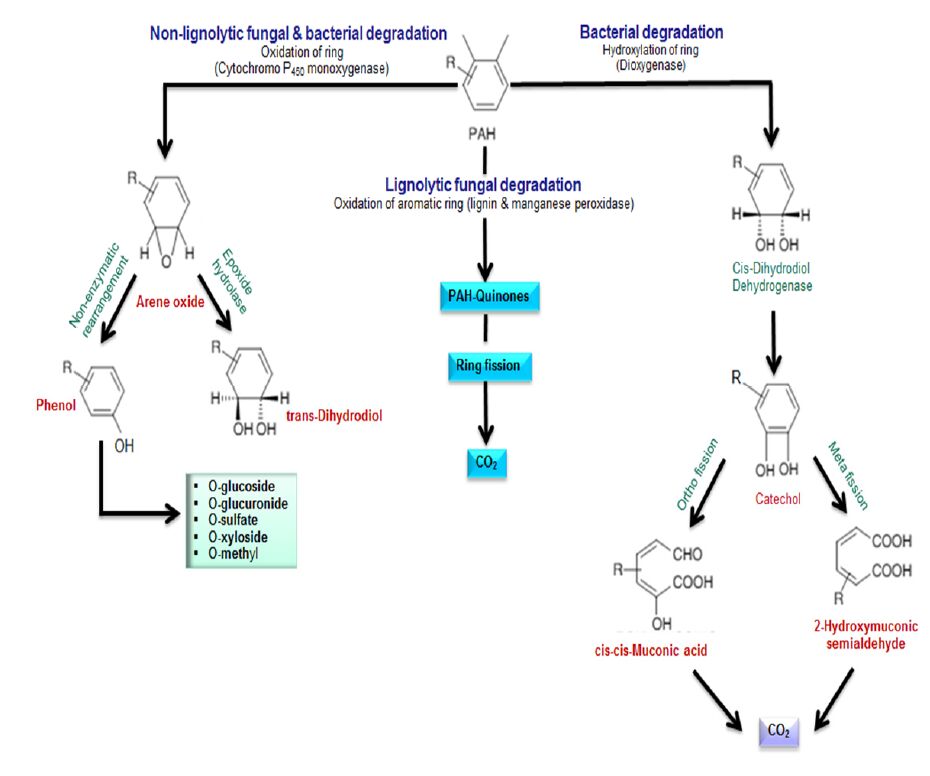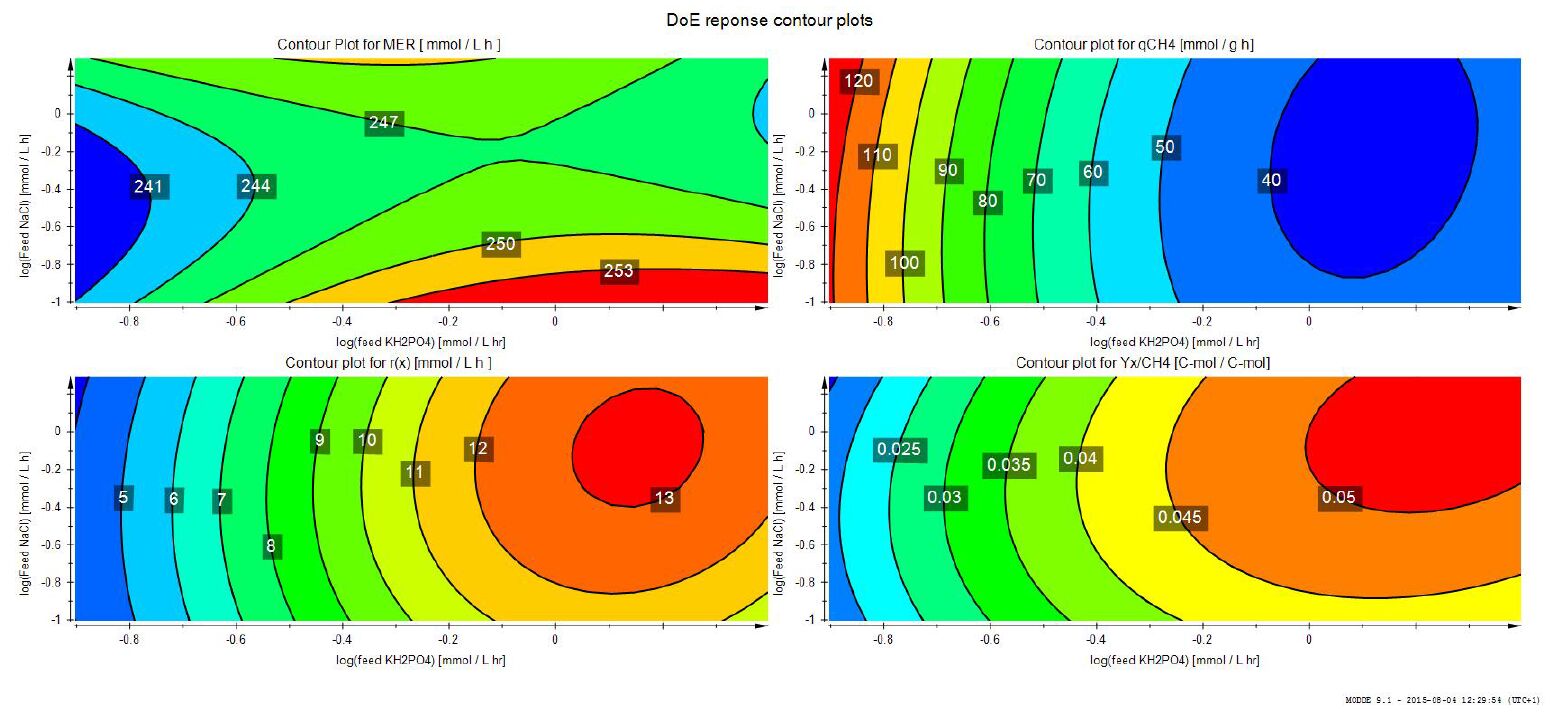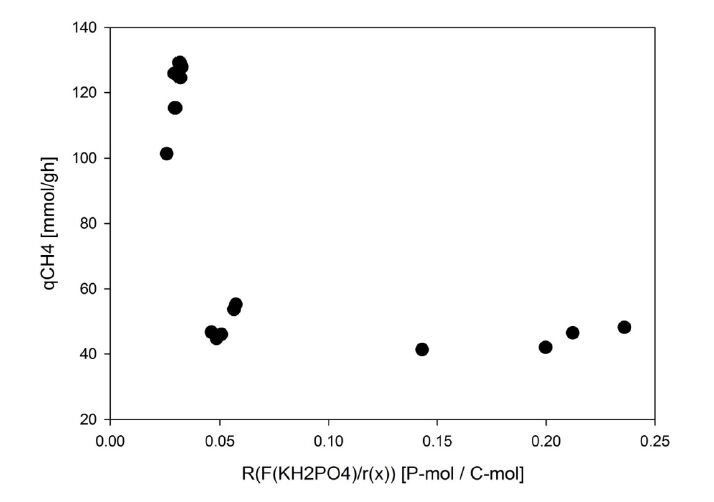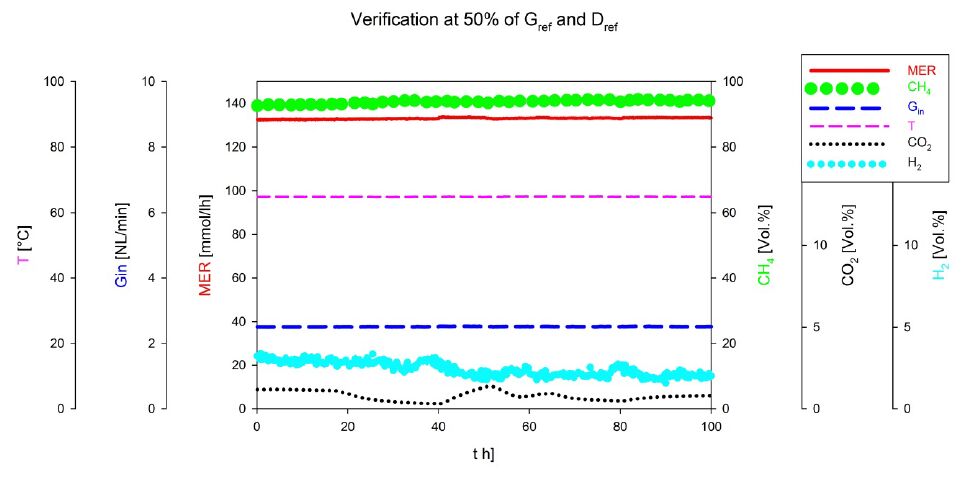| 1.
|
Annela Semai, Frédéric Plewniak, Armelle Charrié-Duhaut, Amalia Sayeh, Lisa Gil, Céline Vandecasteele, Céline Lopez-Roques, Emmanuelle Leize-Wagner, Farid Bensalah, Philippe N. Bertin,
Characterisation of hydrocarbon degradation, biosurfactant production, and biofilm formation in Serratia sp. Tan611: a new strain isolated from industrially contaminated environment in Algeria,
2021,
114,
0003-6072,
411,
10.1007/s10482-021-01527-5
|
|
| 2.
|
Maryam Rezaei Somee, Mahmoud Shavandi, Seyed Mohammad Mehdi Dastgheib, Mohammad Ali Amoozegar,
Bioremediation of oil-based drill cuttings by a halophilic consortium isolated from oil-contaminated saline soil,
2018,
8,
2190-572X,
10.1007/s13205-018-1261-8
|
|
| 3.
|
Chinedu Christopher Obieze, Chioma Blaise Chikere, Rasheed Adeleke, Onyewuchi Akaranta,
2019,
Formulation and Evaluation of Slow-Release Fertilizer from Agricultural and Industrial Wastes for Remediation of Crude Oil-Polluted Soils,
10.2118/198815-MS
|
|
| 4.
|
Farah Eryssa Khalid, Zheng Syuen Lim, Suriana Sabri, Claudio Gomez-Fuentes, Azham Zulkharnain, Siti Aqlima Ahmad,
Bioremediation of Diesel Contaminated Marine Water by Bacteria: A Review and Bibliometric Analysis,
2021,
9,
2077-1312,
155,
10.3390/jmse9020155
|
|
| 5.
|
Daniela Zuzolo, Carmine Guarino, Maria Tartaglia, Rosaria Sciarrillo,
Plant-Soil-Microbiota Combination for the Removal of Total Petroleum Hydrocarbons (TPH): An In-Field Experiment,
2021,
11,
1664-302X,
10.3389/fmicb.2020.621581
|
|
| 6.
|
Simranjeet Singh, Vijay Kumar, Shivika Datta, Daljeet Singh Dhanjal, Parul Parihar, Joginder Singh,
2021,
9780128211991,
79,
10.1016/B978-0-12-821199-1.00008-0
|
|
| 7.
|
Takamitsu Kai, Hiromi Ikeura, Suzuka Ozawa, Masahiko Tamaki,
Effects of basal fertilizer and perlite amendment on growth of zinnia and its remediation capacity in oil-contaminated soils,
2018,
20,
1522-6514,
1236,
10.1080/15226514.2018.1460310
|
|
| 8.
|
T. Yu. Korshunova, S. P. Chetverikov, M. D. Bakaeva, E. V. Kuzina, G. F. Rafikova, D. V. Chetverikova, O. N. Loginov,
Microorganisms in the Elimination of Oil Pollution Consequences (Review),
2019,
55,
0003-6838,
344,
10.1134/S0003683819040094
|
|
| 9.
|
Charles Oluwaseun Adetunji, Osikemekha Anthony Anani, Deepak Panpatte,
2021,
Chapter 8,
978-981-15-7454-2,
189,
10.1007/978-981-15-7455-9_8
|
|
| 10.
|
Mingqian Xia, Romy Chakraborty, Norman Terry, Rajendra Prasad Singh, Dafang Fu,
Promotion of saltgrass growth in a saline petroleum hydrocarbons contaminated soil using a plant growth promoting bacterial consortium,
2020,
146,
09648305,
104808,
10.1016/j.ibiod.2019.104808
|
|
| 11.
|
Monica Butnariu, Marian Butu,
2020,
Chapter 9,
978-3-030-48689-1,
195,
10.1007/978-3-030-48690-7_9
|
|
| 12.
|
C. J. Okonkwo, N. Liu, J. Li, A. Ahmed,
Experimental thawing events enhance petroleum hydrocarbons attenuation and enzymatic activities in polluted temperate soils,
2021,
1735-1472,
10.1007/s13762-021-03175-8
|
|
| 13.
|
Martina Cecotti, Bibiana M. Coppotelli, Verónica C. Mora, Marisa Viera, Irma S. Morelli,
Efficiency of surfactant-enhanced bioremediation of aged polycyclic aromatic hydrocarbon-contaminated soil: Link with bioavailability and the dynamics of the bacterial community,
2018,
634,
00489697,
224,
10.1016/j.scitotenv.2018.03.303
|
|
| 14.
|
Arumugam Arul Prakash, Natarajan Srinivasa Prabhu, Aruliah Rajasekar, Punniyakotti Parthipan, Mohamad S. AlSalhi, Sandhanasamy Devanesan, Muthusamy Govarthanan,
Bio-electrokinetic remediation of crude oil contaminated soil enhanced by bacterial biosurfactant,
2021,
405,
03043894,
124061,
10.1016/j.jhazmat.2020.124061
|
|
| 15.
|
Weiyi Tao, Junzhang Lin, Weidong Wang, He Huang, Shuang Li,
Biodegradation of aliphatic and polycyclic aromatic hydrocarbons by the thermophilic bioemulsifier-producing Aeribacillus pallidus strain SL-1,
2020,
189,
01476513,
109994,
10.1016/j.ecoenv.2019.109994
|
|
| 16.
|
Polina Galitskaya, Liliya Biktasheva, Polina Kuryntseva, Svetlana Selivanovskaya,
Response of soil bacterial communities to high petroleum content in the absence of remediation procedures,
2021,
28,
0944-1344,
9610,
10.1007/s11356-020-11290-1
|
|
| 17.
|
Hafida Baoune, Juan Daniel Aparicio, Adrian Acuña, Aminata Ould El Hadj-khelil, Leandro Sanchez, Marta Alejandra Polti, Analia Alvarez,
Effectiveness of the Zea mays-Streptomyces association for the phytoremediation of petroleum hydrocarbons impacted soils,
2019,
184,
01476513,
109591,
10.1016/j.ecoenv.2019.109591
|
|
| 18.
|
Carolina Guatemala Hernández, Josefina Barrera-Cortés, Carlos M. Cerda García-Rojas, Mauricio D. Carbajal Tinoco, Teresa Ponce-Noyola, Margarita Sánchez Domínguez, Benjamín Chávez Gómez,
Weathered Railroad Diesel Removed from a Loamy Sand Soil by Means of Mono-rhamnolipids,
2021,
30,
1532-0383,
350,
10.1080/15320383.2020.1854676
|
|
| 19.
|
Tatiana Shapiro, Konstantin Chekanov, Alina Alexandrova, Galina Dolnikova, Ekaterina Ivanova, Elena Lobakova,
Revealing of Non-Cultivable Bacteria Associated with the Mycelium of Fungi in the Kerosene-Degrading Community Isolated from the Contaminated Jet Fuel,
2021,
7,
2309-608X,
43,
10.3390/jof7010043
|
|
| 20.
|
Yu. A. Nikolaev, E. V. Demkina, I. V. Perminova, N. G. Loiko, I. A. Borzenkov, A. E. Ivanona, A. I. Konstantinov, G. I. El’-Registan,
Role of Humic Compounds in Viability Prolongation of the Cells of Hydrocarbon-Oxidizing Bacteria,
2019,
88,
0026-2617,
764,
10.1134/S0026261719060122
|
|
| 21.
|
Haneen I. Eldos, Mohammad Y. Ashfaq, Mohammad A. Al-Ghouti,
Rapid assessment of the impact of microwave heating coupled with UV-C radiation on the degradation of PAHs from contaminated soil using FTIR and multivariate analysis,
2020,
13,
18785352,
7609,
10.1016/j.arabjc.2020.08.031
|
|
| 22.
|
Guixiang Quan, Qinya Fan, Liqiang Cui, Andrew R. Zimmerman, Hailong Wang, Zhiyuan Zhu, Bin Gao, Limin Wu, Jinlong Yan,
Simulated photocatalytic aging of biochar in soil ecosystem: Insight into organic carbon release, surface physicochemical properties and cadmium sorption,
2020,
183,
00139351,
109241,
10.1016/j.envres.2020.109241
|
|
| 23.
|
Eraldo Ferreira Lopes, Josemar Gurgel Da Costa, Ivan Rodrigo Wolf, José Paulo de Araújo Lima, Spartaco Astolfi-Filho,
Draft Genome Sequence of Burkholderia gladioli Coa14, a Bacterium with Petroleum Bioremediation Potential Isolated from Coari Lake, Amazonas, Brazil,
2018,
6,
2169-8287,
e00301-18,
10.1128/genomeA.00301-18
|
|
| 24.
|
Sunita Varjani, Vivek N. Upasani,
Soil Microcosm Study for Bioremediation by a Crude Oil Degrading
Pseudomonas aeruginosa
NCIM 5514
,
2020,
146,
0733-9372,
04020027,
10.1061/(ASCE)EE.1943-7870.0001687
|
|
| 25.
|
Margarita Bakaeva, Elena Kuzina, Lidiya Vysotskaya, Guzel Kudoyarova, Tat’yana Arkhipova, Gulnaz Rafikova, Sergey Chetverikov, Tat’yana Korshunova, Dar’ya Chetverikova, Oleg Loginov,
Capacity of Pseudomonas Strains to Degrade Hydrocarbons, Produce Auxins and Maintain Plant Growth under Normal Conditions and in the Presence of Petroleum Contaminants,
2020,
9,
2223-7747,
379,
10.3390/plants9030379
|
|
| 26.
|
Justyna Staninska-Pięta, Jakub Czarny, Agnieszka Piotrowska-Cyplik, Wojciech Juzwa, Łukasz Wolko, Jacek Nowak, Paweł Cyplik,
Heavy Metals as a Factor Increasing the Functional Genetic Potential of Bacterial Community for Polycyclic Aromatic Hydrocarbon Biodegradation,
2020,
25,
1420-3049,
319,
10.3390/molecules25020319
|
|
| 27.
|
Nishi Kumari Singh, Sangeeta Choudhary,
Bacterial and archaeal diversity in oil fields and reservoirs and their potential role in hydrocarbon recovery and bioprospecting,
2021,
0944-1344,
10.1007/s11356-020-11705-z
|
|
| 28.
|
D.M. Cocarta, D.M. Dumitru, L. Pesciaroli, M. Felli, B. Raduly, S. Crognale,
Cultivable Hydrocarbonoclastic Microbial Community from Historically Polluted Soil: Tests for Consortium Development,
2019,
28,
1532-0383,
334,
10.1080/15320383.2019.1578335
|
|
| 29.
|
Zulfiqar Ahmad, Xuezhi Zhang, Muhammad Imran, Hua Zhong, Shaista Andleeb, Rabail Zulekha, Guansheng Liu, Iftikhar Ahmad, Frederic Coulon,
Production, functional stability, and effect of rhamnolipid biosurfactant from Klebsiella sp. on phenanthrene degradation in various medium systems,
2021,
207,
01476513,
111514,
10.1016/j.ecoenv.2020.111514
|
|
| 30.
|
Huu-Tuan Tran, Chitsan Lin, Xuan-Thanh Bui, Huu-Hao Ngo, Nicholas Kiprotich Cheruiyot, Hong-Giang Hoang, Chi-Thanh Vu,
Aerobic composting remediation of petroleum hydrocarbon-contaminated soil. Current and future perspectives,
2021,
753,
00489697,
142250,
10.1016/j.scitotenv.2020.142250
|
|
| 31.
|
N M Jabbar, A K Mohammed, S M Jabber, E H Kadhim,
The use of Mixed Bacterial Culture to improve the Biodegradation of Diesel Pollution,
2019,
579,
1757-899X,
012011,
10.1088/1757-899X/579/1/012011
|
|
| 32.
|
Polina Galitskaya, Liliya Biktasheva, Sergey Blagodatsky, Svetlana Selivanovskaya,
Response of bacterial and fungal communities to high petroleum pollution in different soils,
2021,
11,
2045-2322,
10.1038/s41598-020-80631-4
|
|
| 33.
|
Natalia Ptaszek, Magdalena Pacwa-Płociniczak, Magdalena Noszczyńska, Tomasz Płociniczak,
Comparative Study on Multiway Enhanced Bio- and Phytoremediation of Aged Petroleum-Contaminated Soil,
2020,
10,
2073-4395,
947,
10.3390/agronomy10070947
|
|
| 34.
|
Daniel Morales‐Guzmán, Fernando Martínez‐Morales, Brandt Bertrand, Nashbly Sarela Rosas‐Galván, Nidya Fabiola Curiel‐Maciel, Karla Verónica Teymennet‐Ramírez, Luis Enrique Mazón‐Román, Alexei Fedorovish Licea‐Navarro, María R. Trejo‐Hernández,
Microbial prospection of communities that produce biosurfactants from the water column and sediments of the Gulf of Mexico,
2020,
0885-4513,
10.1002/bab.2042
|
|
| 35.
|
Slimane Mokrani, El-hafid Nabti,
Heavy metal resistance and bioremediation capacity of rhizospheric strain BioRPaz-3 Pseudomonas azotoformans endowed with antifungal activities and multi-abiotic stress tolerance in in vitro trials,
2020,
2,
2523-3963,
10.1007/s42452-020-03828-2
|
|
| 36.
|
Yu. Nikolaev, I. Borzenkov, N. Loyko, A. Ivanova, T. Kanapatsky, E. Demkina, S. Karabashev, I. Bliznetc, G. El- Registan,
CREATION OF BIOCOMPOSITE MATERIALS FOR OIL SPILL RESPONSE BASED ON THE IMMOBILIZATION OF HYDROCARBON-OXIDIZING BACTERIA ON THE SURFACE OF MICROCAPSULES,
2020,
2312-640X,
314,
10.37747/2312-640X-2020-18-314-316
|
|
| 37.
|
Tianxin Li, Fang Zhang, Xu Wang, Ying Su,
Effect of Lead Zirconate Titanate Bimorph on Soil Microorganisms: A Preliminary Study,
2021,
13,
2071-1050,
4193,
10.3390/su13084193
|
|
| 38.
|
Dwaipayan Sinha, Suchetana Mukherjee, Dakshayani Mahapatra,
2021,
chapter 8,
9781799870623,
205,
10.4018/978-1-7998-7062-3.ch008
|
|
| 39.
|
M. G. Silva, L. M. Volcão, E. R. Seus, M. I. Machado, N. Mirlean, P. R. M. Baisch, F. M. R. da Silva Júnior,
Comparative evaluation of different bioremediation techniques for crude oil-contaminated soil,
2021,
1735-1472,
10.1007/s13762-021-03325-y
|
|
| 40.
|
Attila Bodor, Naila Bounedjoum, Gábor Feigl, Ágnes Duzs, Krisztián Laczi, Árpád Szilágyi, Gábor Rákhely, Katalin Perei,
Exploitation of extracellular organic matter from Micrococcus luteus to enhance ex situ bioremediation of soils polluted with used lubricants,
2021,
03043894,
125996,
10.1016/j.jhazmat.2021.125996
|
|
| 41.
|
Kien A. Vu, Catherine N. Mulligan,
Utilization of a biosurfactant foam/nanoparticle mixture for treatment of oil pollutants in soil,
2022,
29,
0944-1344,
88618,
10.1007/s11356-022-21938-9
|
|
| 42.
|
Mabatho Moreroa, Moses Basitere,
The challenges and treatment of abattoir effluents: a South African perspective,
2022,
17,
1751-231X,
2598,
10.2166/wpt.2022.147
|
|
| 43.
|
Débora Conde Molina, Franco A. Liporace, Carla V. Quevedo,
Optimization of biomass production by autochthonous Pseudomonas sp. MT1A3 as strategy to apply bioremediation in situ in a chronically hydrocarbon-contaminated soil,
2022,
12,
2190-572X,
10.1007/s13205-022-03183-6
|
|
| 44.
|
Ebru Uyar, Özgür Sağlam,
Isolation, screening and molecular characterization of biosurfactant producing bacteria from soil samples of auto repair shops,
2021,
203,
0302-8933,
4929,
10.1007/s00203-021-02483-4
|
|
| 45.
|
Emmanuel Emeka Arinze, Benjamin Nnamdi Ekwueme, Anthony Chibuzo Ekeleme,
The Effect of Soil Particle Sizes on Bioremediation Efficiency of Petroleum Contaminated Soils,
2023,
32,
1532-0383,
274,
10.1080/15320383.2022.2079609
|
|
| 46.
|
Noor M. Jabbar, Saja M. Alardhi, Alaa K. Mohammed, Issam K. Salih, Talib M. Albayati,
Challenges in the implementation of bioremediation processes in petroleum-contaminated soils: A review,
2022,
18,
22151532,
100694,
10.1016/j.enmm.2022.100694
|
|
| 47.
|
Georgia C. Ntroumpogianni, Eleni Giannoutsou, Amalia D. Karagouni, Alexandros L. Savvides,
Bacterial Isolates from Greek Sites and Their Efficacy in Degrading Petroleum,
2022,
14,
2071-1050,
9562,
10.3390/su14159562
|
|
| 48.
|
Nandita Das, Ankita Das, Sandeep Das, Vasudha Bhatawadekar, Prisha Pandey, Kamlesh Choure, Samir Damare, Piyush Pandey,
Petroleum Hydrocarbon Catabolic Pathways as Targets for Metabolic Engineering Strategies for Enhanced Bioremediation of Crude-Oil-Contaminated Environments,
2023,
9,
2311-5637,
196,
10.3390/fermentation9020196
|
|
| 49.
|
Zhe Liu, Meixia Gu, Wei Zhu, Mengru Zhang, Weizhi Zhou,
Petroleum‐contamination drives the shift of microbiome through modifying soil metallome,
2022,
33,
1085-3278,
1718,
10.1002/ldr.4260
|
|
| 50.
|
Cindy Baburam, Alfred Mitema, Tsepo Tsekoa, Naser Aliye Feto,
2022,
Chapter 5,
978-3-030-85464-5,
101,
10.1007/978-3-030-85465-2_5
|
|
| 51.
|
Ritu PANWAR, Jyoti MATHUR,
Remediation of polycyclic aromatic hydrocarbon-contaminated soils using microbes and nanoparticles: A review,
2023,
33,
10020160,
93,
10.1016/j.pedsph.2022.06.032
|
|
| 52.
|
Yingjin Song, Ruiyi Li, Guanyi Chen, Beibei Yan, Lei Zhong, Yuxin Wang, Yihang Li, Jinlei Li, Yingxiu Zhang,
Bibliometric Analysis of Current Status on Bioremediation of Petroleum Contaminated Soils during 2000–2019,
2021,
18,
1660-4601,
8859,
10.3390/ijerph18168859
|
|
| 53.
|
Siddhartha Narayan Borah, Niharika Koch, Suparna Sen, Ram Prasad, Hemen Sarma,
2022,
9780323851602,
643,
10.1016/B978-0-323-85160-2.00024-X
|
|
| 54.
|
Alexis Nzila, Musa M. Musa,
Current Knowledge and Future Challenges on Bacterial Degradation of the Highly Complex Petroleum Products Asphaltenes and Resins,
2021,
9,
2296-665X,
10.3389/fenvs.2021.779644
|
|
| 55.
|
Gessesse Kebede, Tekle Tafese, Ebrahim M. Abda, M. Kamaraj, Fassil Assefa, Yuhe He,
Factors Influencing the Bacterial Bioremediation of Hydrocarbon Contaminants in the Soil: Mechanisms and Impacts,
2021,
2021,
2090-9071,
1,
10.1155/2021/9823362
|
|
| 56.
|
María Guirado, Daniel Garrido-Sanz, Oscar Pindado, Manuel Rodríguez-Rastrero, Luis Merino-Martín, María José Sierra, Olga Escolano, Rafael Rivilla, Rocio Millán,
Effectiveness of biochar application and bioaugmentation techniques for the remediation of freshly and aged diesel-polluted soils,
2021,
163,
09648305,
105259,
10.1016/j.ibiod.2021.105259
|
|
| 57.
|
Essouassi Elikem, Arantxa P. Persico, David Bulmer, Steven D. Siciliano, Paolo Mussone, Derek Peak,
A sustainable colloidal material with sorption and nutrient‐supply capabilities for in situ groundwater bioremediation,
2021,
50,
0047-2425,
1440,
10.1002/jeq2.20293
|
|
| 58.
|
Soni Kumari Singh, Ashish Sachan,
2022,
9780128234433,
419,
10.1016/B978-0-12-823443-3.00007-7
|
|
| 59.
|
Ana B. Medić, Ivanka M. Karadžić,
Pseudomonas in environmental bioremediation of hydrocarbons and phenolic compounds- key catabolic degradation enzymes and new analytical platforms for comprehensive investigation,
2022,
38,
0959-3993,
10.1007/s11274-022-03349-7
|
|
| 60.
|
Nasser Al-Kaabi, Zulfa Al Disi, Mohammad A. Al-Ghouti, Theis Ivan Solling, Nabil Zouari,
Interaction between indigenous hydrocarbon-degrading bacteria in reconstituted mixtures for remediation of weathered oil in soil,
2022,
36,
2215017X,
e00767,
10.1016/j.btre.2022.e00767
|
|
| 61.
|
Paolo Stincone, Robson Andreazza, Carolina Faccio Demarco, Thays França Afonso, Adriano Brandelli,
2023,
Chapter 8,
978-3-031-17225-0,
147,
10.1007/978-3-031-17226-7_8
|
|
| 62.
|
Innocent Chukwunonso Ossai, Fauziah Shahul Hamid, Auwalu Hassan,
2022,
Chapter 4,
978-1-80355-378-8,
10.5772/intechopen.102053
|
|
| 63.
|
Grifoni Martina, Rosellini Irene, Angelini Paolo, Petruzzelli Gianniantonio, Pezzarossa Beatrice, Martina Grifoni,
A Preliminary Study on Lupinus albus and Raphanus sativus Grown in Soil Affected by Oil Spillage,
2021,
107,
0007-4861,
917,
10.1007/s00128-021-03290-9
|
|
| 64.
|
Mirosław Wyszkowski, Natalia Kordala,
Role of Different Material Amendments in Shaping the Content of Heavy Metals in Maize (Zea mays L.) on Soil Polluted with Petrol,
2022,
15,
1996-1944,
2623,
10.3390/ma15072623
|
|
| 65.
|
Di Ma, Jie Xu, Jipeng Zhou, Lili Ren, Jian Li, Zaiwang Zhang, Jiangbao Xia, Huicheng Xie, Tao Wu,
Using Sweet Sorghum Varieties for the Phytoremediation of Petroleum-Contaminated Salinized Soil: A Preliminary Study Based on Pot Experiments,
2023,
11,
2305-6304,
208,
10.3390/toxics11030208
|
|
| 66.
|
Yury Nikolaev, Igor Borzenkov, Elena Demkina, Natalia Loiko, Timur Kanapatsky, Irina Perminova, Alexander Volikov, Anna Khreptugova, Igor Bliznetc, Nadezhda Grigoreva, Galina El-Registan,
Immobilization of Cells of Hydrocarbon-oxidizing Bacteria for Petroleum Bioremediation Using New Materials,
2021,
15,
1735-6865,
971,
10.1007/s41742-021-00367-5
|
|
| 67.
|
Tahany Mahmoud, Walaa S. Gado, A. H. Mady, Khalid I. Kabel,
2022,
Chapter 35-1,
978-3-030-83783-9,
1,
10.1007/978-3-030-83783-9_35-1
|
|
| 68.
|
M. Khazaei, A. Etminan, S. Dashti, S.A. Hosseini,
Assessing the degradation potential of light petroleum hydrocarbons using bacterial activity (Pseudomonas aeruginosa) and root exudate of Conocarpus (Conocarpus erectus),
2021,
24,
23521864,
101865,
10.1016/j.eti.2021.101865
|
|
| 69.
|
Giovanni Gallo, Rosanna Puopolo, Miriam Carbonaro, Emanuela Maresca, Gabriella Fiorentino,
Extremophiles, a Nifty Tool to Face Environmental Pollution: From Exploitation of Metabolism to Genome Engineering,
2021,
18,
1660-4601,
5228,
10.3390/ijerph18105228
|
|
| 70.
|
Mohammad Ali Zahed, Mohammad Ali Matinvafa, Aryandokht Azari, Leila Mohajeri,
Biosurfactant, a green and effective solution for bioremediation of petroleum hydrocarbons in the aquatic environment,
2022,
2,
2730-647X,
10.1007/s43832-022-00013-x
|
|
| 71.
|
Natthariga Laothamteep, Kallayanee Naloka, Onruthai Pinyakong,
Bioaugmentation with zeolite-immobilized bacterial consortium OPK results in a bacterial community shift and enhances the bioremediation of crude oil-polluted marine sandy soil microcosms,
2022,
292,
02697491,
118309,
10.1016/j.envpol.2021.118309
|
|
| 72.
|
Oludaisi Adekomaya, Thokozani Majozi,
Promoting natural cycle and environmental resilience: A pathway toward sustainable development,
2022,
42,
10269185,
229,
10.1016/j.sajce.2022.09.002
|
|
| 73.
|
Tatiana Vyacheslavovna Funtikova, Lenar Imametdinovich Akhmetov, Irina Filippovna Puntus, Pavel Alexeevich Mikhailov, Nurbol Orynbasaruly Appazov, Roza Abdibekovna Narmanova, Andrey Evgenievich Filonov, Inna Petrovna Solyanikova,
Bioremediation of Oil-Contaminated Soil of the Republic of Kazakhstan Using a New Biopreparation,
2023,
11,
2076-2607,
522,
10.3390/microorganisms11020522
|
|
| 74.
|
Manish Kumar, Nanthi Bolan, Tahereh Jasemizad, Lokesh P. Padhye, Srinidhi Sridharan, Lal Singh, Shiv Bolan, James O'Connor, Haochen Zhao, Sabry M. Shaheen, Hocheol Song, Kadambot H.M. Siddique, Hailong Wang, M.B. Kirkham, Jörg Rinklebe,
Mobilization of contaminants: Potential for soil remediation and unintended consequences,
2022,
839,
00489697,
156373,
10.1016/j.scitotenv.2022.156373
|
|
| 75.
|
Pranjal Bharali, Yasir Bashir, Anggana Ray, Nipu Dutta, Pronab Mudoi, Viphrezolie Sorhie, Vinita Vishwakarma, Palash Debnath, Bolin Kumar Konwar,
Bioprospecting of indigenous biosurfactant-producing oleophilic bacteria for green remediation: an eco-sustainable approach for the management of petroleum contaminated soil,
2022,
12,
2190-572X,
10.1007/s13205-021-03068-0
|
|
| 76.
|
Tahany Mahmoud, Walaa S. Gado, A. H. Mady, Khalid I. Kabel,
2023,
Chapter 35,
978-3-031-09709-6,
1651,
10.1007/978-3-031-09710-2_35
|
|
| 77.
|
Balakrishnan Muthukumar, Saravanan Surya, Krithiga Sivakumar, Mohamad S. AlSalhi, Tentu Nageswara Rao, Sandhanasamy Devanesan, Paulraj Arunkumar, Aruliah Rajasekar,
Influence of bioaugmentation in crude oil contaminated soil by Pseudomonas species on the removal of total petroleum hydrocarbon,
2023,
310,
00456535,
136826,
10.1016/j.chemosphere.2022.136826
|
|
| 78.
|
Jaber Neshati, Faraz Biabanaki, Nader Shariatmadari,
An investigation into the efficiency of electrokinetic and electrokinetic coupled with calcium peroxide permeable reactive barriers techniques for soil remediation using a statistical analysis,
2023,
195,
0167-6369,
10.1007/s10661-022-10736-y
|
|
| 79.
|
Robert Kowalik, Małgorzata Widłak, Agata Widłak,
Sorption of Heavy Metals by Sewage Sludge and Its Mixtures with Soil from Wastewater Treatment Plants Operating in MBR and INR Technology,
2021,
11,
2077-0375,
706,
10.3390/membranes11090706
|
|
| 80.
|
Ivica Kisić, Jasna Hrenović, Željka Zgorelec, Goran Durn, Vladislav Brkić, Domina Delač,
Bioremediation of Agriculture Soil Contaminated by Organic Pollutants,
2022,
15,
1996-1073,
1561,
10.3390/en15041561
|
|
| 81.
|
Charles Chinyere Dike, Ibrahim Gbolahan Hakeem, Alka Rani, Aravind Surapaneni, Leadin Khudur, Kalpit Shah, Andrew S. Ball,
The co-application of biochar with bioremediation for the removal of petroleum hydrocarbons from contaminated soil,
2022,
849,
00489697,
157753,
10.1016/j.scitotenv.2022.157753
|
|
| 82.
|
Kallayanee Naloka, Jirakit Jaroonrunganan, Naphatsakorn Woratecha, Nichakorn Khondee, Hideaki Nojiri, Onruthai Pinyakong,
Physiological changes in Rhodococcus ruber S103 immobilized on biobooms using low-cost media enhance stress tolerance and crude oil-degrading activity,
2022,
12,
2045-2322,
10.1038/s41598-022-14488-0
|
|
| 83.
|
Elena Kuzina, Gulnaz Rafikova, Lidiya Vysotskaya, Tatyana Arkhipova, Margarita Bakaeva, Dar’ya Chetverikova, Guzel Kudoyarova, Tatyana Korshunova, Sergey Chetverikov,
Influence of Hydrocarbon-Oxidizing Bacteria on the Growth, Biochemical Characteristics, and Hormonal Status of Barley Plants and the Content of Petroleum Hydrocarbons in the Soil,
2021,
10,
2223-7747,
1745,
10.3390/plants10081745
|
|
| 84.
|
Abel Inobeme, Jaison Jeevanandam, Charles Oluwaseun Adetunji, Osikemekha Anthony Anani, Devarajan Thangadurai, Saher Islam, Olubukola Monisola Oyawoye, Julius Kola Oloke, Mohammed Bello Yerima, Olugbemi T. Olaniyan,
2021,
9780128226964,
89,
10.1016/B978-0-12-822696-4.00010-3
|
|
| 85.
|
Tarun Kumar Kumawat, Varsha Kumawat, Swati Sharma, Nirat Kandwani, Manish Biyani,
2021,
Chapter 11,
978-3-030-75288-0,
285,
10.1007/978-3-030-75289-7_11
|
|
| 86.
|
Khadijah Nabilah Mohd Zahri, Khalilah Abdul Khalil, Claudio Gomez-Fuentes, Azham Zulkharnain, Suriana Sabri, Peter Convey, Sooa Lim, Siti Aqlima Ahmad,
Mathematical Modelling of Canola Oil Biodegradation and Optimisation of Biosurfactant Production by an Antarctic Bacterial Consortium Using Response Surface Methodology,
2021,
10,
2304-8158,
2801,
10.3390/foods10112801
|
|
| 87.
|
E. V. Babynin, I. A. Degtyareva,
Possibilities of using information resources In bioremediation,
2021,
11,
2500-1558,
372,
10.21285/2227-2925-2021-11-3-372-383
|
|
| 88.
|
Gilberto Martins, Sara Campos, Ana Ferreira, Rita Castro, Maria Salomé Duarte, Ana J. Cavaleiro,
A Mathematical Model for Bioremediation of Hydrocarbon-Contaminated Soils,
2022,
12,
2076-3417,
11069,
10.3390/app122111069
|
|
| 89.
|
Gurpreet Kaur, Magdalena Krol, Satinder Kaur Brar,
Geothermal heating: Is it a boon or a bane for bioremediation?,
2021,
287,
02697491,
117609,
10.1016/j.envpol.2021.117609
|
|
| 90.
|
Lucas Martinez Alvarez, Henk Bolhuis, Goh Kian Mau, Chan Kok-Gan, Chan Chia Sing, Walter Mac Cormack, Lucas Ruberto,
Identification of key bacterial players during successful full-scale soil field bioremediation in Antarctica,
2022,
168,
09648305,
105354,
10.1016/j.ibiod.2021.105354
|
|
| 91.
|
Giovanna Carpani, Ilaria Pietrini, Massimiliano Baric, Francesca D'Ambrosi, Carlo Alberto Cova, Jahanzaib Akhtar, Melania Buffagni,
2021,
Bioremediation of Cutting Pits by Autochtonous Bacteria-Fungi Consortia,
10.2118/207921-MS
|
|
| 92.
|
Oxana V. Masyagina, Anastasia I. Matvienko, Tatiana V. Ponomareva, Irina D. Grodnitskaya, Elizaveta V. Sideleva, Valeriy K. Kadutskiy, Svetlana V. Prudnikova, Viktoria S. Bezbido, Kristina A. Kudryavtseva, Svetlana Y. Evgrafova,
Soil contamination by diesel fuel destabilizes the soil microbial pools: Insights from permafrost soil incubations,
2023,
323,
02697491,
121269,
10.1016/j.envpol.2023.121269
|
|
| 93.
|
Chongshu Li, Changzheng Cui, Jie Zhang, Jing Shen, Baoyan He, Yan Long, Jinshao Ye,
Biodegradation of petroleum hydrocarbons based pollutants in contaminated soil by exogenous effective microorganisms and indigenous microbiome,
2023,
253,
01476513,
114673,
10.1016/j.ecoenv.2023.114673
|
|
| 94.
|
A. A. Vetrova, S. Ya. Trofimov, R. R. Kinzhaev, N. A. Avetov, A. V. Arzamazova, I. F. Puntus, O. I. Sazonova, S. L. Sokolov, R. A. Streletskii, K. V. Petrikov, Ya. A. Delegan, V. A. Samoylenko, A. E. Filonov,
Development of Microbial Consortium for Bioremediation of Oil-Contaminated Soils in the Middle Ob Region,
2022,
55,
1064-2293,
651,
10.1134/S1064229322050106
|
|
| 95.
|
Gessesse Kebede Bekele, Solomon Abera Gebrie, Eshetu Mekonen, Tekle Tafese Fida, Adugna Abdi Woldesemayat, Ebrahim M. Abda, Mesfin Tafesse, Fasil Assefa, Todd R. Callaway,
Isolation and Characterization of Diesel-Degrading Bacteria from Hydrocarbon-Contaminated Sites, Flower Farms, and Soda Lakes,
2022,
2022,
1687-9198,
1,
10.1155/2022/5655767
|
|
| 96.
|
Yojana Waychal, Shreya Gawas, Sagar H. Barage,
2022,
Chapter 10,
978-3-030-89983-7,
157,
10.1007/978-3-030-89984-4_10
|
|
| 97.
|
T. Yu. Korshunova, M. D. Bakaeva, E. V. Kuzina, G. F. Rafikova, S. P. Chetverikov, D. V. Chetverikova, O. N. Loginov,
Role of Bacteria of the Genus Pseudomonas in the Sustainable Development of Agricultural Systems and Environmental Protection (Review),
2021,
57,
0003-6838,
281,
10.1134/S000368382103008X
|
|
| 98.
|
Roberto Orellana, Andrés Cumsille, Paula Piña-Gangas, Claudia Rojas, Alejandra Arancibia, Salvador Donghi, Cristian Stuardo, Patricio Cabrera, Gabriela Arancibia, Franco Cárdenas, Felipe Salazar, Myriam González, Patricio Santis, Josefina Abarca-Hurtado, María Mejías, Michael Seeger,
Economic Evaluation of Bioremediation of Hydrocarbon-Contaminated Urban Soils in Chile,
2022,
14,
2071-1050,
11854,
10.3390/su141911854
|
|
| 99.
|
Mahsa Mohammadi, Mohammadreza Khanmohammadi Khorrami, Hamid Vatanparast, Amirmohammad Karimi, Mina Sadrara,
Classification and determination of sulfur content in crude oil samples by infrared spectrometry,
2022,
127,
13504495,
104382,
10.1016/j.infrared.2022.104382
|
|
| 100.
|
A. A. Farouq, H. Y. Ismail, A. B. Rabah, A. B. Muhammad, U. B. Ibrahim, A. Y. Fardami,
Cowpea induced physicochemical and biological rhizosphere changes in hydrocarbon contaminated soil,
2022,
477,
0032-079X,
759,
10.1007/s11104-022-05460-y
|
|
| 101.
|
Bhupendra Nath Tiwary, Reena Das, Vaishali Paul,
2022,
Chapter 20,
978-981-16-5213-4,
589,
10.1007/978-981-16-5214-1_20
|
|
| 102.
|
S. Sreevidya, Kirtana Sankara Subramanian, Yokraj Katre, Ajaya Kumar Singh,
2021,
9780128226964,
291,
10.1016/B978-0-12-822696-4.00003-6
|
|
| 103.
|
Teklit Gebregiorgis Ambaye, Alif Chebbi, Francesca Formicola, Shiv Prasad, Franco Hernan Gomez, Andrea Franzetti, Mentore Vaccari,
Remediation of soil polluted with petroleum hydrocarbons and its reuse for agriculture: Recent progress, challenges, and perspectives,
2022,
293,
00456535,
133572,
10.1016/j.chemosphere.2022.133572
|
|
| 104.
|
Jane Alexander Ruley, Alice Amoding, John Baptist Tumuhairwe, Twaha Ateenyi Basamba,
2022,
9780323898744,
263,
10.1016/B978-0-323-89874-4.00008-X
|
|
| 105.
|
Melinda Mandaresu, Ludovica Dessì, Andrea Lallai, Marco Porceddu, Maria Enrica Boi, Gianluigi Bacchetta, Tiziana Pivetta, Raffaela Lussu, Riccardo Ardu, Marika Pinna, Federico Meloni, Enrico Sanjust, Elena Tamburini,
Helichrysum microphyllum subsp. tyrrhenicum, Its Root-Associated Microorganisms, and Wood Chips Represent an Integrated Green Technology for the Remediation of Petroleum Hydrocarbon-Contaminated Soils,
2023,
13,
2073-4395,
812,
10.3390/agronomy13030812
|
|
| 106.
|
Jonathan Wijaya, Haeil Byeon, Woosik Jung, Joonhong Park, Seungdae Oh,
Machine learning modeling using microbiome data reveal microbial indicator for oil-contaminated groundwater,
2023,
53,
22147144,
103610,
10.1016/j.jwpe.2023.103610
|
|
| 107.
|
Nurzat Totubaeva, Zhiide Tokpaeva, Janarbek Izakov, Mirlan Moldobaev,
Bioremediation approaches for oil contaminated soils in extremely high-mountainous conditions,
2023,
69,
12141178,
188,
10.17221/433/2022-PSE
|
|
| 108.
|
MSc Yuletsis Díaz Rodríguez, Roberto Romero Silva, Danai Hernández Hernández, Claudia Chao Reyes, Carlos C. Cañete Pérez, Silvia Lilibet Acosta Díaz,
Aplicación en campo de la biorremediación mejorada a cortes de perforación contaminados con diésel,
2023,
17,
2683-3360,
e1146,
10.54167/tch.v17i1.1146
|
|
| 109.
|
Tatyana Korshunova, Elena Kuzina, Svetlana Mukhamatdyarova, Yuliyana Sharipova, Milyausha Iskuzhina,
Promising Strains of Hydrocarbon-Oxidizing Pseudomonads with Herbicide Resistance and Plant Growth-Stimulating Properties for Bioremediation of Oil-Contaminated Agricultural Soils,
2023,
13,
2077-0472,
1111,
10.3390/agriculture13061111
|
|
| 110.
|
Yun-Yeong Lee, Soo Yeon Lee, Kyung-Suk Cho,
Phytoremediation and bacterial community dynamics of diesel- and heavy metal-contaminated soil: Long-term monitoring on a pilot scale,
2023,
183,
09648305,
105642,
10.1016/j.ibiod.2023.105642
|
|
| 111.
|
Wei Zheng, ZhiGuo Zhou, Lan Wang, Yang Gao, ShiJun Chen,
Electrochemical Sensors for Detection of Phenol in Oilfield Wastewater Using TiO2/CNTs nanocomposite Modified Glassy Carbon Electrode,
2022,
17,
14523981,
221138,
10.20964/2022.11.44
|
|
| 112.
|
Daoqing Liu, Qianwei Li, Enhui Liu, Miao Zhang, Jicheng Liu, Chunmao Chen,
Biomineralized nanoparticles for the immobilization and degradation of crude oil-contaminated soil,
2023,
1998-0124,
10.1007/s12274-023-5788-6
|
|
| 113.
|
Victoria Koshoffa Akinpelumi, Kwakye George Kumi, Amarachi Paschaline Onyena, Sam Kabari, Anthoneth Ndidi Ezejiofor, Chiara Frazzoli, Osazuwa Clinton Ekhator, Godswill J. Udom, Orish Ebere Orisakwe,
A comparative study of the impacts of Polycyclic Aromatic Hydrocarbons in water and soils in Nigeria and Ghana: Towards a framework for public health protection.,
2023,
27724166,
100336,
10.1016/j.hazadv.2023.100336
|
|
| 114.
|
Mayada K. Kansour, Dina M. Al-Mailem,
Bioremediation of two oil-contaminated Kuwaiti hyper-saline soils by cross bioaugmentation and the role of indigenous halophilic/halotolerant hydrocarbonoclastic bacteria,
2023,
32,
23521864,
103259,
10.1016/j.eti.2023.103259
|
|
| 115.
|
Devargya Ganguly, K. L. V. Prasanna, Swaroopa Neelapu, Gargi Goswami,
2023,
Chapter 19,
978-981-99-2815-6,
549,
10.1007/978-981-99-2816-3_19
|
|
| 116.
|
Ikeabiama Ndubuisi Azuazu, Kabari Sam, Pablo Campo, Frederic Coulon,
Challenges and opportunities for low-carbon remediation in the Niger Delta: Towards sustainable environmental management,
2023,
900,
00489697,
165739,
10.1016/j.scitotenv.2023.165739
|
|
| 117.
|
S. U. Oghoje, C. I. Omoruyi, C. Ojeomo, J. E. Ukpebor, I. H. Ifijen,
Revolutionizing Soil Remediation: Harnessing the Potential of Chicken Manure Digestates for Petroleum Hydrocarbon Contamination,
2023,
2522-5758,
10.1007/s42250-023-00711-6
|
|
| 118.
|
Moirangthem Singh Goutam, Madhava Anil Kumar,
2023,
Chapter 20,
978-981-99-2597-1,
443,
10.1007/978-981-99-2598-8_20
|
|
| 119.
|
Gurpreet Kaur, Joanna Lecka, Magdalena Krol, Satinder Kaur Brar,
Novel BTEX-degrading strains from subsurface soil: Isolation, identification and growth evaluation,
2023,
335,
02697491,
122303,
10.1016/j.envpol.2023.122303
|
|
| 120.
|
Yulia Sotnikova, Anna Grigoriadi, Vadim Fedyaev, Margarita Garipova, Ilshat Galin, Guzal Sharipova, Anna Yamaleeva, Sergey Chetverikov, Dmitriy Veselov, Guzel Kudoyarova, Rashit Farkhutdinov,
Influence of a Hydrocarbon Biodestructor on the Growth and Content of Phytohormones in Secale cereale L. Plants under Petroleum Pollution of the Soil,
2023,
13,
2077-0472,
1640,
10.3390/agriculture13081640
|
|
| 121.
|
Jadwiga Wyszkowska, Agata Borowik, Magdalena Zaborowska, Jan Kucharski,
Biochar, Halloysite, and Alginite Improve the Quality of Soil Contaminated with Petroleum Products,
2023,
13,
2077-0472,
1669,
10.3390/agriculture13091669
|
|
| 122.
|
Mahsa Mohammadi, Mohammadreza Khanmohammadi Khorrami, Arezoo Rezaei, Hamid Vatanparast, Mohammad Mahdi Khanmohammadi Khorrami,
Robust Principal Component Analysis-Multivariate Adaptive Regression Splines (rPCA-MARS) Model for Determining Total Acid Number (TAN) and Total Base Number (TBN) of Crude Oil Samples Using Attenuated Total Reflectance Fourier Transform Infrared (ATR-FTIR) Spectroscopy,
2023,
09242031,
103579,
10.1016/j.vibspec.2023.103579
|
|
| 123.
|
Patricia Giovanella, Rodrigo Gouvêa Taketani, Ruben Gil-Solsona, Luiz Leonardo Saldanha, Samantha Beatríz Esparza Naranjo, Juan V. Sancho, Tania Portolés, Fernando Dini Andreote, Sara Rodríguez-Mozaz, Damià Barceló, Lara Durães Sette,
A comprehensive study on diesel oil bioremediation under microcosm conditions using a combined microbiological, enzymatic, mass spectrometry, and metabarcoding approach,
2023,
1614-7499,
10.1007/s11356-023-29474-w
|
|
| 124.
|
Marina Chugunova, Lyudmila Bakina, Alexander Gerasimov, D. Nazarov, A. Juraeva,
Features of the self-restoration of the oil-contaminated peat-bog soil – a field study,
2023,
67,
2117-4458,
01009,
10.1051/bioconf/20236701009
|
|
| 125.
|
Ponnusamy Kulanthaivel, Ammapalyam Ramasamy Krishnaraja, Suresh Muthusamy, Om Prava Mishra, Mizaj Shabil Sha, Kishor Kumar Sadasivuni,
An Experimental Analysis of Precipitated Silica in Petroleum-Contaminated Clay for the Strengthening of Soil Characteristics,
2023,
2228-6160,
10.1007/s40996-023-01242-3
|
|
| 126.
|
Joshelin Huanca-Juarez, Edson Alexandre Nascimento-Silva, Ninna Hirata Silva, Rafael Silva-Rocha, María-Eugenia Guazzaroni,
Identification and functional analysis of novel protein-encoding sequences related to stress-resistance,
2023,
14,
1664-302X,
10.3389/fmicb.2023.1268315
|
|
| 127.
|
Ákos Ferenc Fazekas, Tamás Gyulavári, Zsolt Pap, Attila Bodor, Krisztián Laczi, Katalin Perei, Erzsébet Illés, Zsuzsanna László, Gábor Veréb,
Effects of Different TiO2/CNT Coatings of PVDF Membranes on the Filtration of Oil-Contaminated Wastewaters,
2023,
13,
2077-0375,
812,
10.3390/membranes13100812
|
|
| 128.
|
Yahaya Y. Riko, Zubairu U. Darma,
2024,
9781119989288,
239,
10.1002/9781119989318.ch15
|
|
| 129.
|
Suzanne C. Henderson, Amalesh Dhar, M. Anne Naeth,
Reclamation of Hydrocarbon Contaminated Soils Using Soil Amendments and Native Plant Species,
2023,
12,
2079-9276,
130,
10.3390/resources12110130
|
|
| 130.
|
Tatiana Minnikova, Anna Ruseva, Sergey Kolesnikov,
2023,
Chapter 18,
978-3-031-37215-5,
225,
10.1007/978-3-031-37216-2_18
|
|
| 131.
|
Oscar Daniel Navas-Cáceres, Mayra Parada, German Zafra,
Development of a highly tolerant bacterial consortium for asphaltene biodegradation in soils,
2023,
1614-7499,
10.1007/s11356-023-30682-7
|
|
| 132.
|
Jamilah Ahmad, Nuratiqah Marsidi, Siti Rozaimah Sheikh Abdullah, Hassimi Abu Hasan, Ahmad Razi Othman, Nur 'Izzati Ismail, Setyo Budi Kurniawan,
Integrating phytoremediation and mycoremediation with biosurfactant-producing fungi for hydrocarbon removal and the potential production of secondary resources,
2024,
349,
00456535,
140881,
10.1016/j.chemosphere.2023.140881
|
|
| 133.
|
Oluwafemi Sunday Obayori, Oluwadamilola Deborah Adesina, Lateef Babatunde Salam, Ahmeed Olalekan Ashade, Francisca Obiageri Nwaokorie,
Depletion of hydrocarbons and concomitant shift in bacterial community structure of a diesel-spiked tropical agricultural soil,
2023,
0959-3330,
1,
10.1080/09593330.2023.2291421
|
|
| 134.
|
Dorjjugder Nasanjargal, Baldorj Pagmadulam, Munkhbayar Uuriintuya, Mendbayar Mend-Amar, Renchindorj Urjinlkham, Khandaa Oyunkhan, Tserennadmid Rentsenkhand,
mini-review of petroleum and sludge bioremediation using microorganisms,
2023,
39,
2788-9823,
151,
10.5564/pib.v39i1.3149
|
|
| 135.
|
Yaru Wang, Shuo Sun, Qiyou Liu, Yuhua Su, Hang Zhang, Mingjun Zhu, Fang Tang, Yingying Gu, Chaocheng Zhao,
Characteristic microbiome and synergistic mechanism by engineering agent MAB-1 to evaluate oil-contaminated soil biodegradation in different layer soil,
2024,
1614-7499,
10.1007/s11356-024-31891-4
|
|
| 136.
|
Barbara Bertović, Monika Šabić Runjavec, Nolla Todorović, Ivan Zgrebec, Marija Vuković Domanovac,
Biotechnological Potential of Oil-Tolerant Strains for Possible Use in Bioremediation,
2024,
16,
2071-1050,
563,
10.3390/su16020563
|
|
| 137.
|
Pooja C. Mayekar, Rafael Auras,
Accelerating Biodegradation: Enhancing Poly(lactic acid) Breakdown at Mesophilic Environmental Conditions with Biostimulants,
2024,
1022-1336,
10.1002/marc.202300641
|
|
| 138.
|
Samuel Fosu Gyasi, Mark Kwasi Sarfo, Amos Tiereyangn Kabo-Bah, Bright Adu, Andrew Sarkodie Appiah, Yaw Serfor-Armah,
In vitro assessment of crude oil degradation by Acinetobacter junii and Alcanivorax xenomutans isolated from the coast of Ghana,
2024,
10,
24058440,
e24994,
10.1016/j.heliyon.2024.e24994
|
|
| 139.
|
Li Fan, Xianhe Gong, Quanwei Lv, Denghui Bin, Li’Ao Wang,
Construction of Shale Gas Oil-Based Drilling Cuttings Degrading Bacterial Consortium and Their Degradation Characteristics,
2024,
12,
2076-2607,
318,
10.3390/microorganisms12020318
|
|
| 140.
|
Sudesh Kumar,
2023,
Chapter 10,
978-3-031-48219-9,
205,
10.1007/978-3-031-48220-5_10
|
|
| 141.
|
Chioma B. Ehis-Eriakha, Stephen E. Akemu, Damilola O. Osofisan,
2024,
0,
2754-6713,
10.5772/intechopen.114081
|
|
| 142.
|
Emmanuel Oliver Fenibo, Rosina Nkuna, Tonderayi Matambo,
Impact of artisanal refining activities on bacterial diversity in a Niger Delta fallow land,
2024,
14,
2045-2322,
10.1038/s41598-024-53147-4
|
|
| 143.
|
Bassazin Ayalew Mekonnen, Tadele Assefa Aragaw, Melkamu Birlie Genet,
Bioremediation of petroleum hydrocarbon contaminated soil: a review on principles, degradation mechanisms, and advancements,
2024,
12,
2296-665X,
10.3389/fenvs.2024.1354422
|
|
| 144.
|
Kevin C. Lee, Stephen D.J. Archer, Mayada K. Kansour, Dina M. Al-Mailem,
Bioremediation of oily hypersaline soil via autochthonous bioaugmentation with halophilic bacteria and archaea,
2024,
922,
00489697,
171279,
10.1016/j.scitotenv.2024.171279
|
|
| 145.
|
G. K. Vasilyeva, E. R. Strijakova, J. J. Ortega-Calvo,
2024,
Chapter 1080,
1867-979X,
10.1007/698_2024_1080
|
|
| 146.
|
Charles Chinyere Dike, Alka Rani Batra, Leadin S. Khudur, Kamrun Nahar, Andrew S. Ball,
Effect of the Application of Ochrobactrum sp.-Immobilised Biochar on the Remediation of Diesel-Contaminated Soil,
2024,
12,
2305-6304,
234,
10.3390/toxics12040234
|
|
| 147.
|
Godwin U. A., Inu N. U.,
Effect of Crude Oil Contamination on Microbial Community Structure and Urease Activity in Coastal Plain Sands of Uyo, Akwa Ibom State, Nigeria,
2024,
7,
2689-9434,
51,
10.52589/AJENSR-28GRZZ4K
|
|
| 148.
|
Jonathan Wijaya, Joonhong Park, Yuyi Yang, Sharf Ilahi Siddiqui, Seungdae Oh,
A metagenome-derived artificial intelligence modeling framework advances the predictive diagnosis and interpretation of petroleum-polluted groundwater,
2024,
03043894,
134513,
10.1016/j.jhazmat.2024.134513
|
|
| 149.
|
Kelly Hidalgo-Martinez, Admir José Giachini, Marcio Schneider, Adriana Soriano, Marcus Paulus Baessa, Luiz Fernando Martins, Valéria Maia de Oliveira,
Shifts in structure and dynamics of the soil microbiome in biofuel/fuel blend–affected areas triggered by different bioremediation treatments,
2024,
1614-7499,
10.1007/s11356-024-33304-y
|
|
| 150.
|
Yong-Tao Li, Qin Sui, Xi Li, Xin-Yue Liu, Hao Liu, Yu-Qin Wang, Wan-Ying Du,
Remediation of diesel contaminated soil by using activated persulfate with Fe3O4 magnetic nanoparticles: effect and mechanisms,
2024,
1614-7499,
10.1007/s11356-024-33408-5
|
|
| 151.
|
Mingjian Zhang, Qing Chen, Zheng Gong,
Microbial remediation of petroleum-contaminated soil focused on the mechanism and microbial response: a review,
2024,
1614-7499,
10.1007/s11356-024-33474-9
|
|
| 152.
|
Wenjie Yu, Minglei Yang, Yuzhu Liu,
Real-time in situ detection of petroleum hydrocarbon pollution in soils via a novel optical methodology,
2024,
13861425,
124526,
10.1016/j.saa.2024.124526
|
|
| 153.
|
Fatemah Aghazadeh Amiri, Nafisah Aghazadeh Amiri, Pouria Karimi, Akbar Eslami, Leila Faravardeh, Mohammad Rafiee, Abolghasem Ghasemi,
Bioaugmentation of Bio-Slurry Reactor Containing Pyrene Contaminated Soil by Engineered Pseudomonas putida KT2440,
2024,
235,
0049-6979,
10.1007/s11270-024-07186-2
|
|
| 154.
|
Mohamad Reza Fadaei Tehrani, Ali Asghar Besalatpour,
A combined landfarming-phytoremediation method to enhance remediation of mixed persistent contaminants,
2024,
1614-7499,
10.1007/s11356-024-33606-1
|
|
| 155.
|
Achmad Buhori, Juwon Lee, Min Ji Cha, Jung Ho Ahn, Sung Ok Han, Jae-Wook Choi, Kwang Ho Kim, Jeong-Myeong Ha, Gyeongtaek Gong, Chun-Jae Yoo,
Synthesis of biosurfactants from polyethylene waste via an integrated chemical and biological process,
2024,
12,
22133437,
113322,
10.1016/j.jece.2024.113322
|
|
| 156.
|
Elena Nikitina, Valeriya Smirnova, Angelina Danilova,
Possibilities of spectral analysis methods for the oil sludge research,
2024,
5,
2782-1900,
127,
10.52957/2782-1900-2024-5-2-127-132
|
|
| 157.
|
Adama Sawadogo, Hama Cissé, Harmonie Cécile Otoidobiga, Ismail A. Odetokun, Cheikna Zongo, Dayéri Dianou, Aly Savadogo,
Characterization of two bacterial strains isolated from wastewater and exhibiting in-vitro degradation of diesel and used oils,
2024,
24682276,
e02289,
10.1016/j.sciaf.2024.e02289
|
|
| 158.
|
Elena Nikitina, Valeriya Smirnova, Angelina Danilova,
Vozmozhnosti spektral`ny`x metodov analiza v issledovanii nefteshlamov,
2024,
5,
2782-1900,
55,
10.52957/2782-1900-2024-5-2-55-60
|
|
| 159.
|
Afrah Siddique, Zulfa Al Disi, Mohammad AlGhouti, Nabil Zouari,
Diversity of hydrocarbon-degrading bacteria in mangroves rhizosphere as an indicator of oil-pollution bioremediation in mangrove forests,
2024,
205,
0025326X,
116620,
10.1016/j.marpolbul.2024.116620
|
|
| 160.
|
Shanky Jindal, Kamal Krishan Aggarwal,
Pseudomonas aeruginosa PR23 isolated from oil contaminated soil tolerate and degrades mixture of polyaromatic hydrocarbons and express novel proteins,
2024,
40,
0959-3993,
10.1007/s11274-024-04071-2
|
|
| 161.
|
Aimée D. Schryer, Steven D. Siciliano,
Do phosphorus amendments enhance biodegradation activity in stalled petroleum hydrocarbon‐contaminated soil?,
2024,
0047-2425,
10.1002/jeq2.20594
|
|
| 162.
|
Sahaya Nadar, Tabassum Khan,
2024,
9781119851127,
257,
10.1002/9781119851158.ch17
|
|
| 163.
|
Ewelina Zając, Monika J. Fabiańska, Elżbieta Jędrszczyk, Tomasz Skalski,
Hydrocarbon Degradation and Microbial Survival Improvement in Response to γ-Polyglutamic Acid Application,
2022,
19,
1660-4601,
15066,
10.3390/ijerph192215066
|
|
| 164.
|
Małgorzata Widłak, Renata Stoińska, Robert Kowalik,
Assessment of physical and chemical pollution of urban agglomeration soils,
2020,
199,
19443986,
137,
10.5004/dwt.2020.25980
|
|
| 165.
|
Roda F. Al-Thani, Bassam T. Yasseen,
Methods Using Marine Aquatic Photoautotrophs along the Qatari Coastline to Remediate Oil and Gas Industrial Water,
2024,
12,
2305-6304,
625,
10.3390/toxics12090625
|
|
| 166.
|
Małgorzata Widłak, Robert Kowalik, Szymon Sobura,
Quality of the soil and water environment in the immediate vicinity of the Barania Gora Forest Reserve,
2021,
232,
19443986,
404,
10.5004/dwt.2021.27604
|
|
| 167.
|
Parviz Behdarvandan, Reza Jalilzadeh Yengejeh, Sima Sabzalipour, Laleh Roomiani, Khoshnaz Payandeh,
Evaluating effect of aeration and sand addition on soil physicochemical properties and soil total petroleum hydrocarbon bioremediation efficiency by indigenous isolated bacteria,
2024,
0277-2248,
1,
10.1080/02772248.2024.2421236
|
|
| 168.
|
Balázs Libisch,
N-Alkane Assimilation by Pseudomonas aeruginosa and Its Interactions with Virulence and Antibiotic Resistance,
2024,
13,
2079-6382,
1028,
10.3390/antibiotics13111028
|
|
| 169.
|
Anastasiia T. Davletgildeeva, Nikita A. Kuznetsov,
Bioremediation of Polycyclic Aromatic Hydrocarbons by Means of Bacteria and Bacterial Enzymes,
2024,
12,
2076-2607,
1814,
10.3390/microorganisms12091814
|
|
| 170.
|
Chinedu Emeka Ihejirika, Joseph Ifeanyichukwu Garricks, Ejeagba Okorie Imo, Joseph Ikechukwu Nwachukwu, Ihuoma Ezichi Mbuka-Nwosu, Etienne Chukwuma Chinakwe, Ursula Ngozi Nwaogwugwu, Christopher Chibuzor Ejiogu, Obenade Moses,
Biodegradation efficiencies of Low Pour Fuel Oil by Pseudomonas aeruginosa and Bacillus
licheniformis isolates,
2024,
1,
3020-7886,
1,
10.70099/BJ/2024.01.04.15
|
|
| 171.
|
Samira Pakdel, Ali Beheshti Ale Agha, Rouhallah Sharifi, Alireza Habibi, Firoozeh Gholami,
Diesel-degradation by indigenous bacteria of petroleum-contaminated soils,
2024,
1618-1905,
10.1007/s10123-024-00616-5
|
|
| 172.
|
Eziafakaego M. Ibo, Aina O. Adeogun, Michael U. Orji, Odera R. Umeh,
Harnessing microbial synergy: A comprehensive evaluation of consortia-mediated bioremediation strategies for petroleum refinery wastewater treatment,
2024,
2,
29502632,
100055,
10.1016/j.clwat.2024.100055
|
|
| 173.
|
Lucas M. Martínez Álvarez, Francisco Massot, Martin Andres Diaz, W.P. Mac Cormack, Lucas A.M. Ruberto,
2025,
9780443217036,
701,
10.1016/B978-0-443-21703-6.00013-8
|
|
| 174.
|
Wei-Ting Chen, Ku-Fan Chen, Der-Shyan Sheu, Rao Y. Surampalli, Tian C. Zhang, Chih-Ming Kao,
Development of a Novel Lyophilization Method for the Production of Bacterial Strain Powders to Enhance the Cleanup Efficiency of Petroleum Hydrocarbon–Polluted Soils,
2025,
151,
0733-9372,
10.1061/JOEEDU.EEENG-7735
|
|
| 175.
|
Katie E. Howland, Jack J. Mouradian, Donald R. Uzarski, Michael W. Henson, Donald G. Uzarski, Deric R. Learman, Arpita Bose,
Nutrient amendments enrich microbial hydrocarbon degradation metagenomic potential in freshwater coastal wetland microcosm experiments,
2024,
0099-2240,
10.1128/aem.01972-24
|
|
| 176.
|
Pratik Kakde, Jaigopal Sharma,
Microbial Bioremediation of Petroleum Contaminated Soil: Structural Complexity, Degradation Dynamics and Advanced Remediation Techniques,
2024,
18,
09737510,
2244,
10.22207/JPAM.18.4.28
|
|
| 177.
|
Kuok Ho Daniel Tang,
Phytoremediation of Petroleum Hydrocarbons: An Update of Its Recent Progress,
2024,
2,
3009-0806,
10.53623/tebt.v2i2.532
|
|
| 178.
|
Zhuorong Du, Xudong Wang, Zhao Song, Baikang Zhu, Lijuan Feng, Zhi Chen, Qingguo Chen,
Effect of konjac glucomannan aerogel‐immobilized Chlorella vulgaris LH‐1 on oil‐contaminated seawater remediation and endogenous bacterial community diversity,
2025,
97,
1061-4303,
10.1002/wer.70009
|
|
| 179.
|
K.J. Hidalgo, L.G. Cueva, A.J. Giachini, M.R. Schneider, A.U. Soriano, M.P. Baessa, L.F. Martins, V.M. Oliveira,
Long-term microbial functional responses in soil contaminated with biofuel/fossil fuel blends triggered by different bioremediation treatments,
2025,
02697491,
125685,
10.1016/j.envpol.2025.125685
|
|
| 180.
|
Bzhwen Khalid Majeed, Dler M.S Shwan, Khasraw Abdullah Rashid,
A review on environmental contamination of petroleum hydrocarbons, its effects and remediation approaches,
2025,
2050-7887,
10.1039/D4EM00548A
|
|
| 181.
|
Musa Manga, Herbert Cirrus Kaboggoza, Swaib Semiyaga, Lauren Sprouse, Jiahui Guo, Anais Gentles, Yashraj Banga, Sarah Lebu, Chimdi Muoghalu,
2025,
9780323998895,
149,
10.1016/B978-0-323-99889-5.00009-8
|
|
| 182.
|
Rantim Bhattacharjee, Bhaskar Venkateswaran Parli,
Marine siderophores and its implications in changing polar ecosystem: a review,
2025,
48,
0722-4060,
10.1007/s00300-025-03355-z
|
|
| 183.
|
Audrey Vauloup, Aurélie Cébron,
Development of a device to trap soil bacteria capable of degrading organic contaminants such as alkanes and polycyclic aromatic hydrocarbons,
2025,
03043894,
137690,
10.1016/j.jhazmat.2025.137690
|
|
| 184.
|
Dian Andriani, Rina Andriyani, Astari Prabandani, Mutia Dewi Yuniati, Dede Heri Yuli Yanto, Nur Syamimi Zaidi, Mohd Hafiz Puteh,
Characterization and Treatment Methods of Hazardous Compounds in Batik Wastewater: A Review,
2025,
19,
1735-6865,
10.1007/s41742-025-00741-7
|
|
| 185.
|
Sima Abdoli, Behnam Asgari Lajayer, Sepideh Bagheri Novair, Gordon W. Price,
Unlocking the Potential of Biosurfactants in Agriculture: Novel Applications and Future Directions,
2025,
17,
2071-1050,
2110,
10.3390/su17052110
|
|
| 186.
|
Mihaela Marilena Stancu,
Investigating the Potential of Native Soil Bacteria for Diesel Biodegradation,
2025,
13,
2076-2607,
564,
10.3390/microorganisms13030564
|
|
| 187.
|
Kashif Hussain, Muhammad Hassan Bashir, Hamaad Raza Ahmad, Muhammad Tahir Shehzad, Amna Zulfqar,
Modeling source identification of dust and paint metals effecting workshops indoor air quality: associated contamination and cancer risk,
2025,
11,
2363-6203,
10.1007/s40808-025-02372-5
|
|
| 188.
|
Mohammad Kamranifar, Hamidreaza Pourzamani, Rasoul Khosravi, Gholamhassan Ranjbar, Karim Ebrahimpour,
Phytotoxic effects of petroleum hydrocarbons on germination and growth of the native halophyte Salicornia sinus persica in oil contaminated soil,
2025,
15,
2045-2322,
10.1038/s41598-025-92512-9
|
|
| 189.
|
Matthew Chidozie Ogwu, Aliu Olugbemiga Ojo, Amarachi Chekosiba Alaka,
2025,
Chapter 5,
978-3-031-81965-0,
113,
10.1007/978-3-031-81966-7_5
|
|
| 190.
|
Roda F. Al-Thani, Bassam T. Yasseen,
The Role of Phytoplankton in Phycoremediation of Polluted Seawater: Risks, Benefits to Human Health, and a Focus on Diatoms in the Arabian Gulf,
2025,
17,
2073-4441,
920,
10.3390/w17070920
|
|
| 191.
|
M. B. Ryumin, O. G. Lopatovskaya, D. I. Stom, A. N. Chesnokova, O. S. Sutormin, A. B. Kupchinsky, S. V. Alferov, Yu. Yu. Petrova, Z. B. Yessimsiitova, V. V. Fedina, Yu. V. Artemenko,
Changes in some agrophysical characteristics of oil-contaminated soils following their washing with polysorbate 80 solutions,
2025,
15,
2500-1558,
67,
10.21285/achb.968
|
|
| 192.
|
Yilong Ju, Oara Neumann, Sara B. Denison, Peixuan Jin, Andres B. Sanchez-Alvarado, Peter Nordlander, Thomas P. Senftle, Pedro J. J. Alvarez, Ankit Patel, Naomi J. Halas,
In silico machine learning–enabled detection of polycyclic aromatic hydrocarbons from contaminated soil,
2025,
122,
0027-8424,
10.1073/pnas.2427069122
|
|
| 193.
|
Ebhohon Endurance Odion, Jiaojiao Ma, Chuxia Lin,
Optimizing irrigation water use for cost-effective rhizoremediation of oil-contaminated soils with special reference to arid regions,
2025,
389,
03014797,
126149,
10.1016/j.jenvman.2025.126149
|
|
| 194.
|
Sayanti De, Soumyadeep Biswas, Subhra Satahrada, Nirmalya Pal, Sandeep Kumar Panda, Ritesh Pattnaik,
2025,
Chapter 10,
978-3-031-86700-2,
181,
10.1007/978-3-031-86701-9_10
|
|
| 195.
|
A. A. Adewusi, O. Oyedeji, S. M. Adeyemo, O. O. Awotoye,
Isolation, characterization, and hydrocarbon-degrading potentials of microorganisms from bitumen-polluted soils of Agbabu, Ondo State, Nigeria,
2025,
1735-1472,
10.1007/s13762-025-06580-5
|
|
| 196.
|
Alugunulla Venkata Narayana, Prasun Kumar, Boddu Sumalatha, Kuppam Chandrasekhar, Ambati Ranga Rao, Inampudi Rashmika,
Biosurfactants as Key Agents in Microbial Remediation of Polycyclic Aromatic Hydrocarbons: A Review,
2025,
16,
0974-2328,
9,
10.51847/TImJVEmxU3
|
|
| 197.
|
Katarzyna Wojtowicz, Teresa Steliga, Tomasz Skalski, Piotr Kapusta,
Influence of Biosurfactants on the Efficiency of Petroleum Hydrocarbons Biodegradation in Soil,
2025,
17,
2071-1050,
6520,
10.3390/su17146520
|
|
| 198.
|
Sudipta Chakraborty, Avishek Talukdar, Satarupa Dey, Sayan Bhattacharya,
Role of fungi, bacteria and microalgae in bioremediation of emerging pollutants with special reference to pesticides, heavy metals and pharmaceuticals,
2025,
3,
2731-9431,
10.1007/s44274-025-00217-7
|
|









 DownLoad:
DownLoad: 